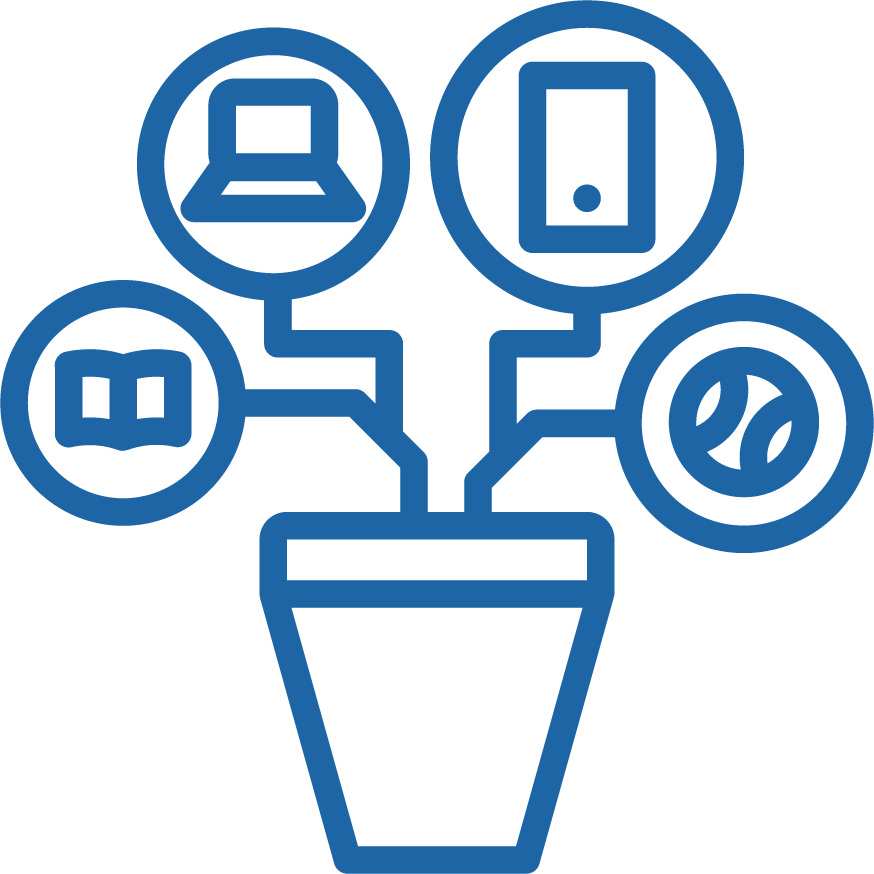| Overview | Prepare to Scale | Envision Scaled Implementation | Set Scaling Goals | Identify a Pathway | Build Your Team | Go to Market |
|---|
Envision Scaled Implementation
If 10,000 schools adopted your product tomorrow, what would implementation look like? What resources and support would district and school leaders and teachers need? And importantly, what organizational and technical capacities would be required to attract and support buyers and users? Review the considerations below for preparing your product for scale and building repeatable processes that enable growth without exponentially increasing complexity or effort.
Envisioning Your Product at Scale
One decision point that will help you envision your product at scale is determining how your product will be sold and distributed. Typically, this falls into one of two ways: adoption by education agencies, which is commercially called “business-to-business,” or B2B; or direct sales to individual teachers, students, or families/caregivers, which is commercially called “business-to-consumer,” or B2C. Some providers may use both B2B and B2C, but they keep a strategic focus on each. For example, they may prioritize selling to education agencies while also offering a direct-to-consumer option to expand access to their product.

Stories of Scaling Highlight
Pictoword School is a B2B product that stemmed from an initial B2C product, the Pictoword app, which has more than 40 million downloads from direct users. Learn more about Kooapp’s transition to expand from B2C to B2B in Game-Changer: Pictoword School’s Scaling Journey from Playful Pastime to Classroom Tool.
The Distribution Channel Considerations resource can help you think about which distribution channel aligns best with your vision. The blog post Who Are the Customers for EdTech Innovations? expands on these considerations for educational technologies in the postsecondary market.
Whether you plan to scale to education agencies (B2B) or individuals (B2C), consider the three areas below to help you prepare for the realities of scaled implementation and envision the support and infrastructure needed to scale sustainably.
Training and ongoing support. Widescale adoption requires implementation with users who are entirely unfamiliar with your product or who are in contexts that you may not have studied or considered. With this in mind, it is essential to think about customer and user education early and often. Customer and user education initiatives could encompass documentation, training, and user communities that focus on better understanding the core features of the product that must be in place and what can be adapted to ensure success across different contexts. The Canvas K-12 User Community is an example of robust customer education programming from Instructure, a leading learning management system provider.
Alignment with other products and needs. Users will implement your product in conjunction with other products. For example, if you offer a Tier 2 or 3 intervention, users will also be implementing a Tier 1 curriculum; if your product is a digital assessment, they will have a separate grading platform and aligned curricular materials. Thinking about the ecosystem of products used in a school or classroom will help you understand how your solution may be integrated into the users’ day-to-day workflow. You can share this information with customers and users to help them envision scaled implementation, and you may also identify opportunities to partner or build on your product based on that alignment.

Stories of Scaling Highlight
The creator of Cognitive ToyBox, a play-based early childhood assessment tool, recognized the need to align and integrate curriculum and assessment. To address this need, the team obtained curriculum goals from districts and aligned the product based on those goals. For example, in Texas the team was able to provide an alignment between the leading early childhood curriculum and Cognitive ToyBox assessments. Providing this complete solution was key to the company’s product growth.
Recently, Cognitive ToyBox announced a partnership with its first curriculum provider. The curriculum has been fully integrated into the Cognitive ToyBox assessment system, and the partner company will be responsible for selling the bundled product. Read the Cognitive ToyBox Story of Scaling to learn more.
Product adaptations. Consider the ways a user might want or need to adapt your product to meet their specific context and goals. For example, a product’s recommended use might be three times a week for 30 minutes, but a school has allocated student pull-outs only twice a week. Or a literacy product may be designed for middle school students, but a teacher wants to use it for high school students who are not reading on grade level. Provide guidance with your product that identifies the core components that must be maintained to achieve the intended effects and what can be modified to “make the product work” for end users.
“Whether it is a professional development program or a product, really be very clear about the things that are essential and the variety of ways we can get to those essential components. Think about that as you are doing outreach. Having clarity about what is essential allows you to work in partnership with rural communities to say is this a fit and here are the ways in which we can be flexible to do that.”
—Linda Friedrich in Designing and Scaling for Educational Impact in Rural Communities.
If you are scaling to education agencies (B2B), you must also consider behavioral and systemic changes outside of the classroom to prepare for implementation. District or school adoption often requires more than just buying the product; systemic changes must also occur. This means you need to plan for not only what teachers must change in the classroom, but anticipate and support the needs of district and school leaders to change the way teachers are organized, trained, and supported.
Additionally, district and school leaders need to make hard choices about where to allocate funding each academic year. The ability to measure the implementation and impact of a product can provide these leaders with evidence that it should be sustained. Consider resources that can help school and district leaders prepare, implement, evaluate, and sustain your product, such as leader-level trainings, implementation checklists, teacher observation protocols, or readiness-assessment tools. The blog post Strategies for Successful Scaling in Districts: Breaking the Cycle of the ‘Next New Thing’ offers strategies to support scaling and institutionalizing practices within a district.
Envisioning Your Team and Workflow at Scale
Scaling is not just about growing revenue or adding more customers; it is about building repeatable processes that enable growth without exponentially increasing complexity or effort. Well-designed systems allow your team to focus on strategic growth rather than getting bogged down by manual, time-consuming tasks. This includes having the right technology, tools, and infrastructure in place to automate routine work, create seamless workflows, and improve visibility across team members.
A thoughtful approach to creating this internal infrastructure will save time, reduce manual errors, and give you the flexibility needed to grow efficiently. Refer to the worksheet Internal Systems and Tools for Scale for a breakdown of key categories and recommended systems or tools that can help your organization scale effectively while optimizing productivity and efficiency. Note that you do not need all of these systems or tools at once. Instead, focus on building a minimal set of systems and tools that supports your immediate needs, and then expand it as you grow.
![]()
Notice and Reflect
While envisioning scaled implementation, take time to pause to notice and reflect. Consider the following questions:
- When you envision scaled implementation, what assumptions do you have about the context, users, and communities using your product?
- What differentiated supports may be needed to scale implementation in under-resourced communities?
- How can internal tools and processes help you monitor the accessibility and distribution of your product among different student populations?

Spotlight Resource
Internal Systems and Tools for Scale. This fillable worksheet provides considerations for internal systems and tools to support scale.
Distribution Channel Considerations. This resource provides considerations to help you identify which distribution channel aligns best with your product and goals.

LEARN More
Strategies for Successful Scaling in Districts: Breaking the Cycle of the ‘Next New Thing’. This blog post shares strategies to support scaling and institutionalizing practices within a district.
Who Are the Customers for EdTech Innovations? This multimedia blog post discusses B2B and B2C considerations for educational technologies in the postsecondary market.
Customer Education and Community: The Scale Engines of Customer Success. This blog post from Gainsight describes how customer education drives scaling and provides examples of what activities and products to include in a portfolio of customer support.
Stories of Scaling: Pictoword. This story profiles the development and scaling journey of the vocabulary development app Pictoword, including the company’s transition from a B2C to B2B provider.
Stories of Scaling: Cognitive ToyBox. This story profiles the development and scaling journey of the early childhood assessment tool, Cognitive ToyBox, including how the developers sought to align their assessment with curriculum and partner to offer bundled curriculum and assessment.
How to Scale Evidence-Based Approaches: Four Insights from Rob Horner. This blog post provides useful insights into how to prepare for successfully scaling an evidence-based approach at the district level.
